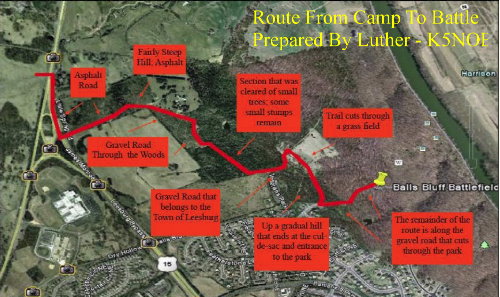Introduction
By Luther Guise - K5NOB, 2011 President, Loudoun Amateur Radio Group
On the 21st day of October 1861 the Battle of Ball's Bluff took place in Loudoun County, Virginia, between the town of Leesburg and the Potomac River. It was notable for being a battle in which the only U.S. Senator in American history was killed in combat. One hundred and fifty years ago the hams weren't there but they were for the sesquicentennial. Responding to a request by the Morven Park Event Coordinator, the Northern Virginia Regional Park Authority and the Loudoun County Fire, Rescue, and Emergency Management Special Events Coordinator to provide communications support for the event, the Loudoun Amateur Radio Group (LARG) went in to action. Besides a battle reenactment at Ball's Bluff Regional Park, the approximately 1,000 Civil War re-enactors were required to complete a mile long trek across Route 15, along hilly unpaved farm roads and cleared woods from their bivouac area at Morven Park to the battle site at Ball's Bluff.
Movement To The Reenactment
|
The Reenactment
Commentary By Norm Styer - AI2C
Video By Bryan Stephens - KG4UPR
Was this was all a mistake? First, the Union Scouts misidentified fallen trees as a new encampment on the bluff. This triggered orders for a raiding party that involved too many on both sides. The 1700 Confederates with the higher ground did well with loses of 36, 117 wounded and 3 captured; as compared with, the 1700 Union forces who never managed to organize, reenforce and attack in strength having to ferry the Potomac River across Harrison Island to the 150-foot bluff while being directed by less experienced command. Union loses were great: 223 killed, 226 wounded and 553 captured. Many bodies were found days later on down the Potomac River toward Washington D.C. This was the next Union lose after Manassas. A special Congressional inquiry was launch to investigate the debacle. The following on-line U.S. Army Staff Ride Guide on the battle is worth reading.
| PREFACE to Staff Ride Guide BATTLE OF BALL'S BLUFF by Ted Ballard CENTER OF MILITARY HISTORY UNITED STATES ARMY WASHINGTON, D. C., 2001 "On the night of 20 October 1861, Union Brig. Gen. Charles P. Stone put into action a plan to attack what had been reported as a small, unguarded Confederate camp between the Potomac River at Ball's Bluff and Leesburg, Virginia. Later, after Stone learned there was no camp, he allowed the operation to continue, now modified to capture Leesburg itself. But a lack of adequate communication between commanders, problems with logistics, and violations of the principles of war hampered the operation. What originally was to be a small raid instead turned into a military disaster. The action resulted in the death of a popular U.S. senator and long-time friend of President Abraham Lincoln, the arrest and imprisonment of General Stone, and the creation of a congressional oversight committee that would keep senior Union commanders looking over their shoulders for the remainder of the war. For such a small and relatively insignificant military action, Ball's Bluff would cast a long shadow.The purpose of a Ball's Bluff staff ride is to learn from the past by analyzing the battle through the eyes of the men who were there, both leaders and rank-and-file soldiers. The battle contains many lessons in command and control, communications, intelligence, weapons technology versus tactics, and the ever-present confusion, or "fog," of battle. Hopefully, these lessons will allow us to gain insights into decision making and the human condition during combat...." Read More |
The Reenactment
|
Loudoun Amateur Radio Group Support
By Luther Guise - K5NOB, 2011 President, Loudoun Amateur Radio Group
Working in close coordination with the Loudoun County Fire and Rescue, locations along the route were determined primarily by the terrain or grade changes and the likelihood of an injury. LARG members were assigned to those locations and at each of the first aid stations. Loudoun Fire and Rescue also posted a "gator" with an EMT team mid route for any emergencies. "Gators" were also available at Morven Park and Ball's Bluff Aid Stations to provide emergency transport in needed.
Member of the Loudoun Amateur Radio Group volunteering communications support:
